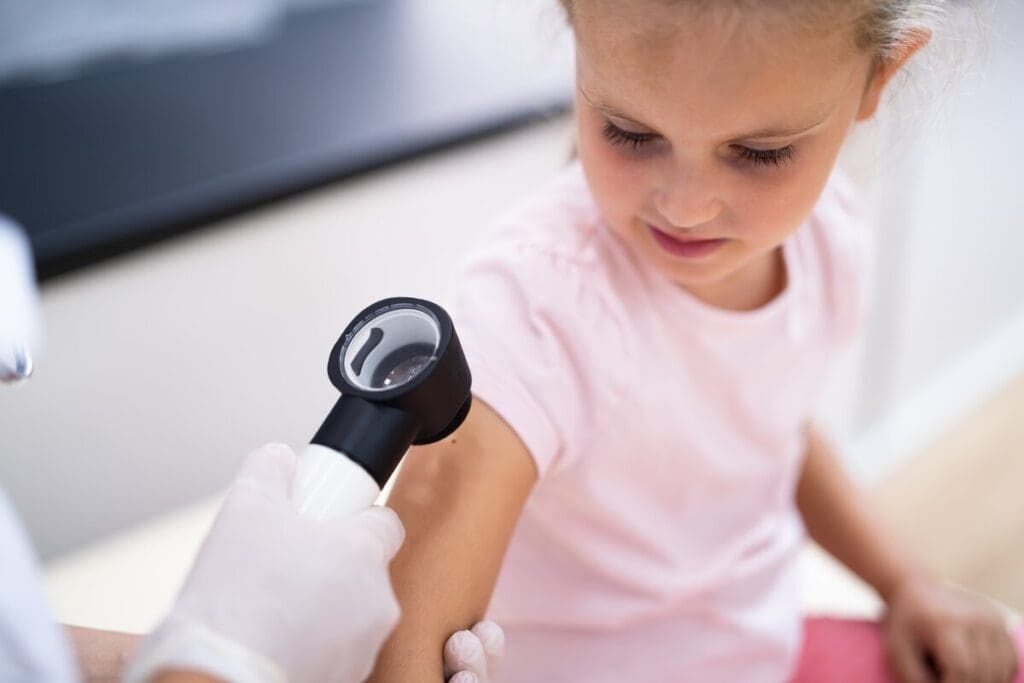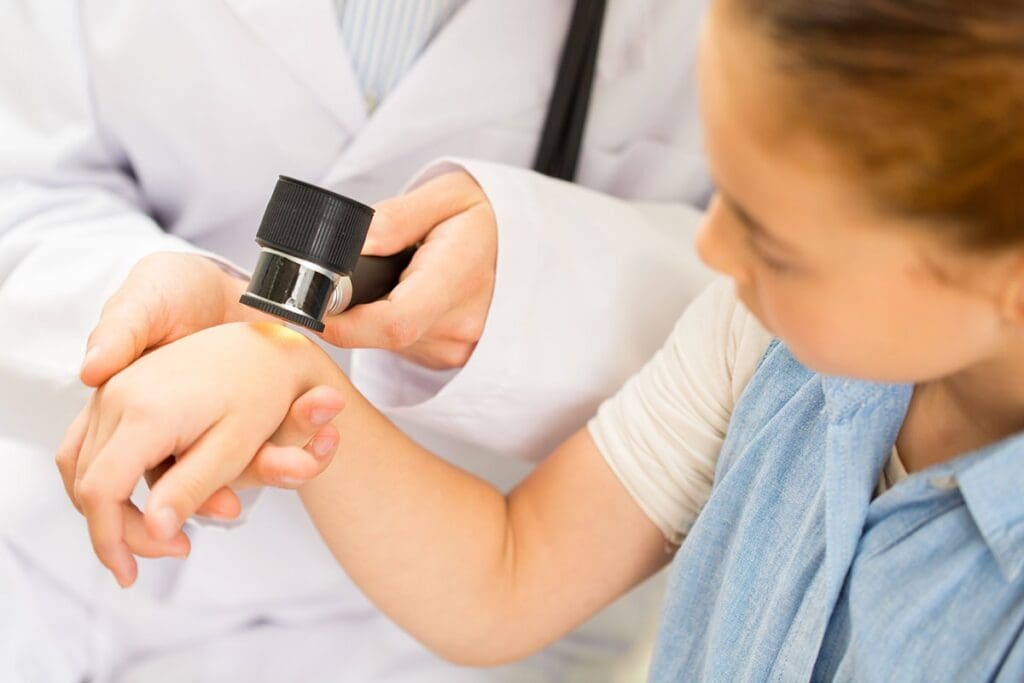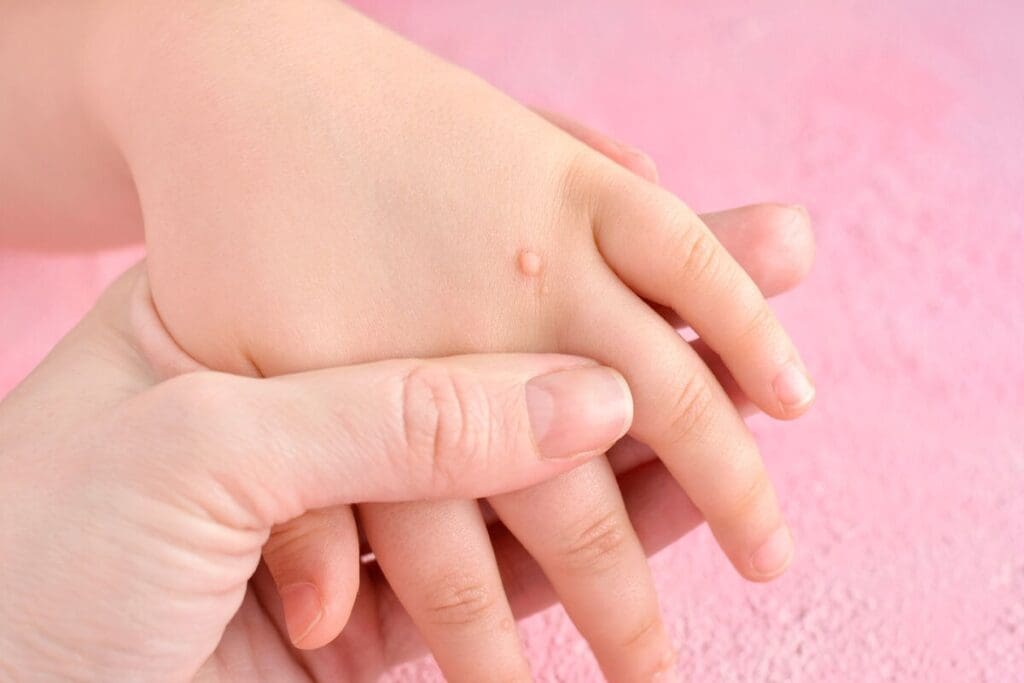Last Updated on November 24, 2025 by
Pediatric dermatology deals with a wide range of skin disorders in kids. These can be mild or severe and really affect a child’s life.

It’s very important to know about these issues to manage and treat them well. Kids often get pediatric rashes and children’s skin bumps. This worries parents and doctors a lot.
LivHospital is dedicated to giving top-notch care to kids with childhood skin rashes and other skin problems.
Pediatric dermatology deals with many skin issues in kids. It’s a big concern for parents and doctors. The number of these problems varies by place and study, showing we need more data.
Research shows skin diseases in kids can affect 4% to over 37%. For example, a study in Egypt found 37.9% of school kids had a skin issue. This shows how important it is to know the global numbers to help with healthcare.

Pediatric kinds skin diseases can really affect kids’ lives. They can make daily tasks hard, hurt their feelings, and harm their health. Eczema, acne, and other skin problems can be very painful and upsetting. We need a full plan to handle these issues, including stopping problems before they start, finding good treatments, and helping kids and their families.
Children can face many skin diseases that affect their daily lives. These issues can come from genetics, the environment, and infections. It’s important to manage these conditions well.
Some common skin issues in kids include atopic dermatitis, acne vulgaris, verrucas (warts), and fungal infections. Atopic dermatitis, or eczema, makes the skin itchy and inflamed. It often runs in families with allergies.
Acne usually starts in the teens, causing spots and sometimes scars. Warts are caused by a virus and can pop up anywhere. Fungal infections, like ringworm, can hit the skin, hair, and nails.
These conditions can really affect a child’s life. They need good treatment and care.

The types of skin issues can change based on where you live and who you are. For example, acne vulgaris hits teens hard, while atopic dermatitis can affect kids of all ages. Things like climate and lifestyle can also play a part.
Seasons can also change how common certain skin issues are. For example, viral infections might go up in the summer. Knowing these patterns can help prevent and manage skin problems.
Inflammatory skin diseases are common in kids, affecting their quality of life. They need quick diagnosis and treatment to keep their skin healthy.
Atopic dermatitis, or eczema, is a common skin problem in kids. It makes the skin itchy and inflamed. This can really impact a child’s daily life and sleep.
Effective management includes using topical corticosteroids, moisturizers, and avoiding triggers.
The exact cause of atopic dermatitis is not known. But it involves genetics, environment, and the immune system. Early intervention can help control symptoms and reduce complications.
Seborrheic dermatitis is another common skin problem in kids. It usually affects the scalp, causing scaly, itchy patches. Treatment often involves medicated shampoos and topical creams.
This condition is believed to be related to an overproduction of skin oils and a sensitivity to a yeast that lives on the skin. Mild cases can be managed with gentle skin care and anti-dandruff shampoos.
Contact dermatitis occurs when the skin reacts to an irritant or allergen. This leads to inflammation and discomfort. In kids, common irritants include soaps, detergents, and certain plants. Identifying and avoiding the causative agent is key to managing the condition.
Symptoms can range from mild redness to severe blistering. Treatment involves removing the irritant and using topical treatments to soothe the skin.
Understanding these inflammatory skin conditions is vital for caring for pediatric patients. By recognizing symptoms and causes, healthcare providers can offer targeted treatments. This improves children’s skin health and overall well-being.
Infectious skin problems are a big worry in kids’ health. They can make kids uncomfortable and even lead to serious issues if not treated properly. It’s key to know the different kinds of skin infections in kids to help them get better.
Viral infections are common in kids and can cause skin problems. Molluscum contagiosum and warts are two examples. These infections spread easily, often through touching someone who’s sick or touching things they’ve touched.
These infections show up as spots or rashes on the skin. For example, molluscum contagiosum looks like small, pearly bumps.
Bacterial infections are also a big deal in kids’ skin health. Impetigo is a common one, showing up as red sores, often on the face. It’s very contagious and can spread to other parts of the body or to others.
A study showed that 18.9% of school kids had skin infections. Bacterial infections need antibiotics to stop them from getting worse.
Fungal infections, like ringworm, are also common in kids. Ringworm causes a circular rash and itches. It spreads easily, through touching someone or something that’s infected.
To treat fungal infections, doctors use antifungal medicines. This can be creams or pills, depending on how bad the infection is.
Knowing about these infections is important for dealing with different childhood rashes and skin disorders types. Spotting these problems early helps parents and doctors give the right care to kids with pediatric rashes.
Puberty often brings acne, a common skin issue in young people. Acne vulgaris is common in teens, causing skin bumps and lesions. These can be upsetting.
Acne is more than a skin problem. It can hurt a child’s self-esteem and quality of life. Knowing what causes it and how to treat it is key.
Acne vulgaris starts with hormonal changes in puberty. This leads to more sebum, clogged pores, and bacteria. Family history also plays a part, as kids with a family history of acne are more likely to get it.
Common presentations of acne vulgaris include:
Treatment for acne in kids and teens depends on how bad it is. Mild cases can be treated with topical creams like retinoids and benzoyl peroxide. These help unclog pores and fight bacteria.
For more severe cases, doctors might prescribe oral antibiotics or hormonal treatments. It’s important for parents and caregivers to work with a dermatologist. This helps find the best treatment early on, preventing long-term damage.
Pediatric skin disorders can be caused by many risk factors. It’s important to know these to prevent them. Childhood skin rashes and diseases of the integumentary system can really affect kids’ lives.
Several factors can lead to these conditions. Knowing these risk factors helps in preventing and managing pediatric skin disorders.
A family history of skin issues is a big risk factor. Genetic predisposition is key in conditions like atopic dermatitis and psoriasis. Kids with a family history of allergies or skin conditions are more likely to get them too.
Environmental factors like poor sanitation and crowded living can raise the risk of skin infections. Lifestyle choices, like exposure to irritants or allergens, also play a part in skin disorders.
To prevent pediatric skin disorders, keep good hygiene and avoid irritants. Protecting against too much sun is also important. Early action and teaching kids about skin care can greatly lower the risk and severity of these issues.
By knowing the risk factors and using preventive measures, parents and caregivers can help reduce childhood skin rashes and other skin problems.
LivHospital leads in treating children’s skin problems with the newest methods. They keep up with the latest in pediatric dermatology. This helps them offer top-notch care for kids with different skin issues.
At LivHospital, they focus on what kids need. They work hard to make sure kids get better from skin problems. This shows they are true leaders in caring for kids’ skin.
They use the newest research and treatments to help kids. LivHospital’s way of dealing with pediatric dermatology shows they care deeply about kids’ health. They want to make sure kids are healthy and happy.
Common issues in kids include atopic dermatitis, acne, verrucas (warts), and fungal infections. These problems can really affect a child’s life. They need the right care and treatment.
Skin diseases in kids vary widely. They can affect up to 37% of schoolchildren, depending on where they live. For example, in Egypt, 37.9% of schoolkids had a skin issue.
Risk factors for kids’ skin problems include family history and poor living conditions. Too much sun and certain lifestyles also matter.
To prevent common skin issues, keep kids clean and avoid irritants. Protect them from too much sun. Knowing the risks helps prevent or lessen these problems.
Treating acne in kids depends on how bad it is. It might need topical or oral meds. Knowing what causes and shows acne is key to treating it well.
Conditions like atopic dermatitis and seborrheic dermatitis can really hurt a kid’s life. They cause itching, discomfort, and skin inflammation. Getting the right diagnosis and treatment is very important.
Subscribe to our e-newsletter to stay informed about the latest innovations in the world of health and exclusive offers!